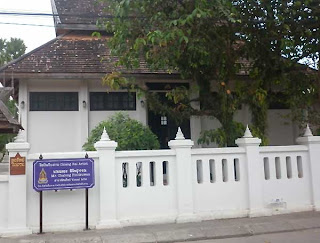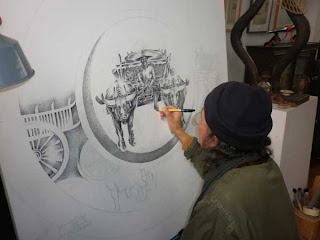
Jong's family with mine
Chiang Rai Trekking And Guiding Service (see www.chiangraitreks.com)
Trekking – day trips or longer, to visit mountain-top hill-tribe villages, waterfalls and the unspoiled nature of the Thai province with the most national park area – has long been a favorite tourist activity here. And Ah-Jong has long been one of ChiangRai’s best guides.
Jong is what friends call Sompong Laophong, a Government-licensed professional trekking and jungle guide based in ChiangRai City of in Northern Thailand. The forests, jungles and mountain areas of the Golden Triangle area there are world renowned for their unique cultural and biological diversity. Jong can show you the wonders of this special region, scheduled to your particular interests, abilities and needs, whether as a tourist, professional scientist or naturalist, as an experienced mountaineer or just as a day tripper. For those interested in the cultural offerings, history, temples and monuments of Lanna, as we call our region, a variety of specialized tours to satisfy your curiosity and enliven your stay in Chiang Rai are available. Jong is multilingual, fluent in Thai, Mandarin Chinese and Akha, and also speaking English and Lahu. He’s especially knowledgeable of the natural resources of the area, ranging from the identification of medicinal and edible plants to indigenous birds, mammals and insects... and is well-known in many traditional villages.
Contact: Tel: (66) 081-111-2733, e-mail: chiangraiguide.jong@gmail.com

Orn’s Bookstore, at 1051/61 JetYod Soi 1, Chiangrai 57000, tel. 081-0220818 (English) or 086-0624080 (Thai), offers the best book-exchange deals in Thailand. The manager, Peter (Orn is his wife), an Asia old-hand (like myself, 20 years here), hails from a small village in the Black Forest of Bavaria, but speaks fluent Thai. He lived in Malaysia then ran ChiangMai’s Supreme Guest House for a decade, amassing a large collection of books left behind by tenants. Return and exchange deals are more than fair, tea can be purchased, and there are lots of friendly cats – when in Chiang Rai, be sure to pay a visit!


Chalong Pintsuwan’s Tai Yuan Art Gallery, 250 Mu 15, Rajyotha Road Soi 3, Chiangrai 57000 (call in advance for appointment, 053-712137 or 089-631-9438, e-mail Taiyuan_artgallery@hotmail.com) is my candidate for Chiangrai’s best gallery. Many artists are represented, including most of the area’s significant ones, and upstairs, in his studio, is a fine collection of fascinating local artifacts.


Aphirak Punmoonsilp, impressionistic painter of flowers in outdoor spaces, lives and works at 79 Mu 10, Ban Mai Pattana, Tambon Pasang, Amphoe Mae Chan, Chiangrai 57110. To visit, make an appointment by calling 081-603-2758 or ew-mail art!punmoonsilp.com. See also www.aphirak-punmoonsilp.com
Naris Rattanawimol carves stone into gracious Buddha images, at Naris Sculpture House, 119 Mu 4, Tambon Wiang Pangcome, Amphoe Mae Sai, Chiangrai 57130
Although Taksin’s absurdly misguided OTOP (One Tambon One Product) policy did much to degrade the quality of Thai crafts (having made my living at the time through crafts export from here, I have some expertise on the matter), there remain a variety of interesting artistic forms on sale in ChiangRai. Weavings, basketry, silverwork, jade, wooden frames, wood carvings, pottery and tea pots, amulets, effigies and other talismans can all be found at the night Bazaar, along Tanalai Road, Highway 1, and at Wat Jedi Luang (next to the National Museum) in Chiang Saen. The Silver Birch shop on Pahonyothin Road by the soi to Wat Jet Yod is by far ChiangRai’s best general crafts store, with some truly amusing items. Don’t forget, Buddha images usually require an export permit.












